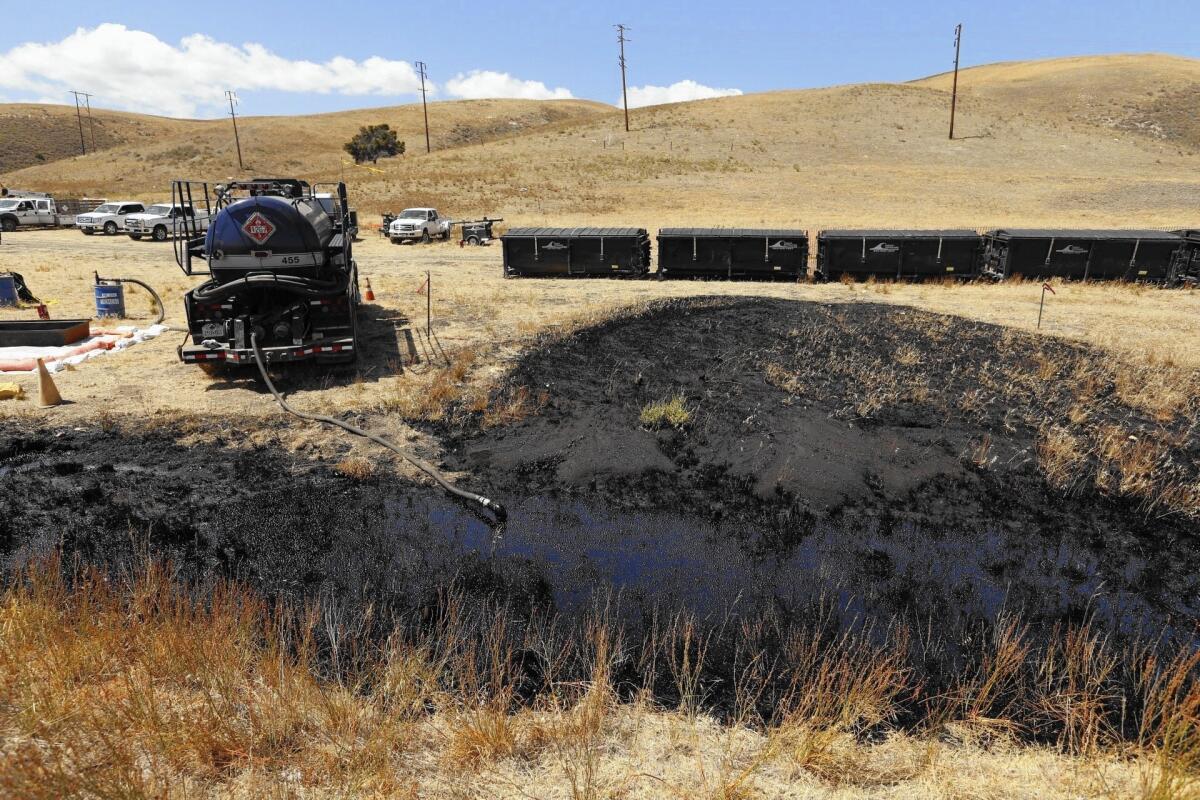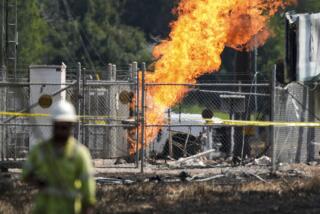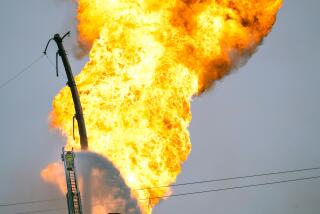Owner of ruptured oil pipeline has history of big spills, fines

Nearly two decades ago, Plains All American Pipeline embarked on a buying spree across the United States and Canada, acquiring thousands of miles of aging pipeline.
The purchases turned Plains into one of North America’s biggest energy pipeline companies. But it also left the firm with a patchwork of pipes, some in need of crucial maintenance.
Mechanical failures on the company’s network have contributed to more than a dozen spills that have released nearly 2 million gallons of hazardous liquid in the U.S. and Canada since 2004. That does not include more than 100,000 gallons of oil spilled along the Santa Barbara County coast on May 19, about 20,000 gallons of which went into the Pacific Ocean, prompting a massive and ongoing cleanup.
Several beaches have been closed since the spill. More than 100 birds and 58 mammals, including sea lions and dolphins, have died from contact with the oil.
The spill occurred on a section of a 1,750-mile-long pipeline built in 1987 that carries heavy crude from offshore in the Pacific to the Gulf of Mexico in Texas. Plains bought it in 1998 at the start of its acquisition boom.
In preliminary findings released this week, the Pipeline and Hazardous Materials Safety Administration determined the section of pipe was severely corroded and had lost nearly half its wall thickness. One six-inch crack in a section of pipe had been repaired repeatedly, officials noted. A precise cause for the spill has yet to be identified.
Regulators have cited cracked joints, failed screws, faulty pins and an undersized storage tank as causes of previous spills that led to millions of dollars in fines against the company, according to court records and regulatory filings.
Plains, a publicly traded company that transports oil from wells to refineries, has a market value of $18.8 billion and operates roughly 18,000 miles of pipeline in North America.
“They bought a bunch of companies with assets of varying quality,” said Michael Wara, a geochemist and an associate professor of law at Stanford University who specializes in energy and environmental law. “When you do that, you may not always fully understand what you’re acquiring, and that creates risk.”
Plains spokesman Roy Lamoreaux said the previous owners of the pipelines didn’t always maintain them diligently, and the process of bringing newly acquired lines up to Plains’ standards often takes years.
Many of the firms’ larger spills “occurred during the transition period,” Lamoreaux said. But he rejected the notion that the rapid expansion was excessively risky, saying the company performed rigorous “due diligence” before each purchase and invested the necessary “catch-up capital” to make the pipelines safe.
The U.S. Environmental Protection Agency sued the company in 2010 for a series of spills in Texas, Louisiana, Oklahoma and Kansas that discharged 273,420 gallons of crude. In all, the company was required to pay $3.25 million in fines and spend $41 million to upgrade more than 10,000 miles of pipe.
The largest of the spills cited in the lawsuit occurred in December 2004 in the tiny West Texas town of Iraan. The rupture, caused by a cracked weld joint, discharged roughly 189,000 gallons of oil. Some of that crude wound up in the nearby Pecos River, according to court documents.
The second-largest spill, in the East Texas city of Longview, occurred a month later. A faulty pressure relief pin and an undersized secondary relief tank were blamed for discharging about 50,000 gallons of oil, some of which reached the Sabine River, court documents show.
Those spills came months after Plains executives essentially doubled the size of the company by purchasing another large pipeline operator.
The EPA lawsuit represented the strongest enforcement action federal pipeline regulators could take. Within weeks of the filing, the company agreed to pay the fines and comply with a long list of safety requirements, including weekly aerial patrols of its pipelines to check for leaks.
Two more-recent spills by the company’s Canadian subsidiary, Plains Midstream, cost the company $1.2 million in combined fines from authorities.
The first occurred in 2011 near Little Buffalo, Canada, when a 30-year-old weld failed on a pipeline laid in 1966. Plains purchased that line in 2008.
The spill released more than a million gallons of crude and became the second-largest in the province of Alberta’s history.
The oil flowed into marshlands near the community of Little Buffalo, where a beaver dam prevented it from going farther. A persistent odor from the oil forced a nearby school to close for several days.
Investigators found that, before the spill, the company’s leak detection gauges produced readings 20 times the level that would indicate a problem, but the operator failed to report the issue to his supervisor and shut down the pipeline. Investigators noted that the company had “few written policies regarding leak detection,” according to court records.
The second spill, into the Red Deer River near Sundre, in 2012, occurred when heavy flooding caused the pipeline to fail. Many residents were treated at a local hospital for respiratory complaints. A recreational reservoir downstream from the spill closed for three weeks.
In that case, a report from the Alberta Energy Regulator — the provincial agency that oversees the oil industry — found, among other things, that “Plains failed to complete inspections of the pipeline at the required frequency” that its own maintenance standards outlined. The regulator said the company also failed to inspect the pipeline “annually as required by the [federal] Pipeline Rules,” and failed to take precautionary measures to prevent flood damage, despite warnings from provincial authorities.
Plains bought the Red Deer River line in 2006 as the company moved to become a player in Canada’s fast-growing oil and gas market.
Last year, another pipe the company owns ruptured in the Atwater Village neighborhood of Los Angeles and sent oil shooting more than 20 feet in the air. It rained down on a nearby strip club, coating patrons and forcing the club’s evacuation.
Investigators determined that a set of screws holding a valve in place failed, leading to the release of nearly 14,000 gallons of crude.
The mess took several days to clean up and caused more than $3 million in damage to nearby businesses and roads, according to a report by the California state fire marshal.
Companies controlled by Plains All American have in the last decade reported 229 less serious safety and maintenance incidents on pipelines to federal regulators.
Plains Pipeline, the largest of the Plains operations, has reported 179 such incidents since 2006. Among more than 1,700 operators included in a database maintained by the Pipeline and Hazardous Materials Safety Administration, only four reported more incidents than Plains.
The company’s infractions involved pump failure, equipment malfunction, pipeline corrosion and operator error, records show. None of the incidents resulted in injuries, but they caused more than $23 million in property damage — much of that to the company’s own facilities — and spilled more than 688,000 gallons of hazardous liquid, records show.
In the wake of the Santa Barbara County spill, the company has issued daily email updates on its cleanup efforts.
“Plains deeply regrets that this unfortunate incident occurred, and we are sorry for the resulting impact to the environment and wildlife, as well as for any disruption caused to residents and visitors,” the company has said repeatedly in news releases.
Maintaining pipelines is not complicated, said Richard B. Kuprewicz, president of pipeline consulting firm Accufacts Inc., based in Redmond, Wash.
“In 40 years of investigating pipeline incidents, I haven’t seen one that wasn’t preventable,” Kuprewicz said. “There are no such things as accidents.”
Twitter: @jackdolanLAT
Twitter: @julie_cart
More to Read
Sign up for Essential California
The most important California stories and recommendations in your inbox every morning.
You may occasionally receive promotional content from the Los Angeles Times.











